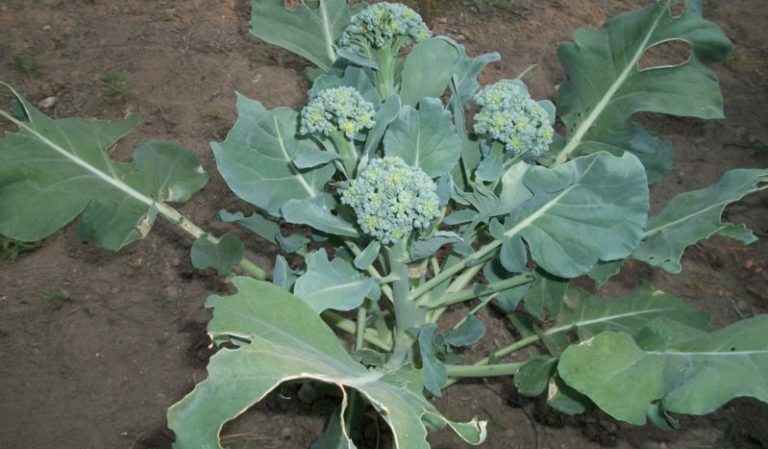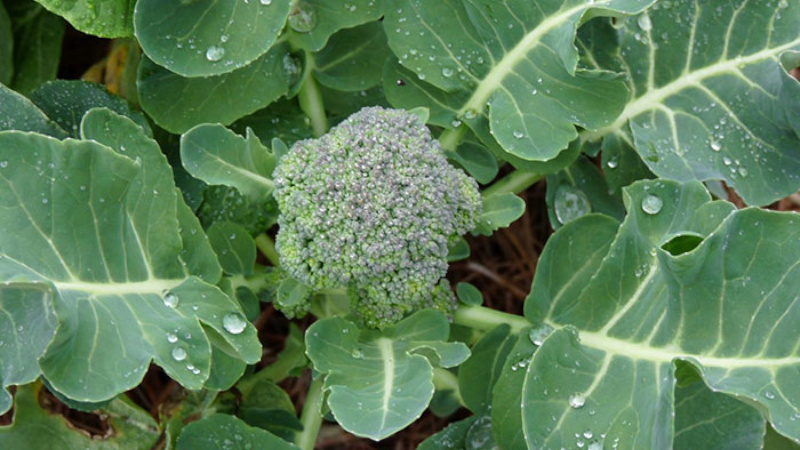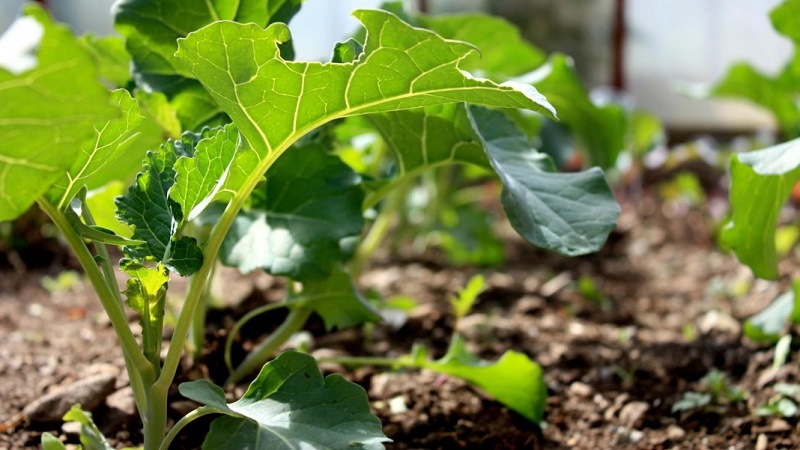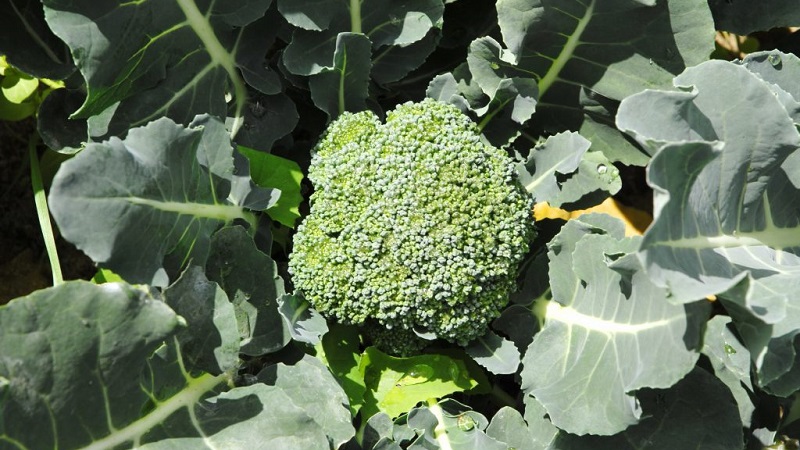Growing broccoli cabbage in the open field in the Moscow region
Despite the fact that broccoli can be grown without problems in a personal summer cottage, many people in Russia and the CIS countries still consider this vegetable exotic. The fears of gardeners associated with a lack of harvest are unjustified - the climatic conditions in Russia are ideal for its cultivation. We will tell you how to grow broccoli in a country house in the open field in the suburbs.
The content of the article
Is it possible to grow broccoli in the Moscow region

Broccolilike any cabbage, it does not like excessively hot weather and grows well in a humid climate and heavy rainfall.
In Central Russia, to which the Moscow region belongs, a temperate continental climate prevails. The average daily air temperature in summer here is + 16 ... + 25 ° C, and these are the most suitable conditions for the growth and development of broccoli.
Reference. The best varieties broccoli for growing in the suburbs and other regions of the Middle Strip - Tone, Leprechaun, Vitamin broccoli.
Methods for growing broccoli cabbage in the open field in the Moscow region
In the climatic conditions of the Moscow region, broccoli is grown seedling and seedless methods, sowing seeds directly into open ground. It is also allowed to grow crops in greenhouses - sowing seeds in a greenhouse allows you to get the earliest or, conversely, the late harvest of vegetables.
Reference. When growing broccoli the first crop is harvested by seedlings in early summer.

Growing seedlings
Agrotechnical techniques for growing and caring for broccoli seedlings are similar to the requirements for sowing cauliflower seeds. At the same time, broccoli ripens earlier - from the moment of sowing seeds to planting seedlings in open ground, it takes a little more than a month.
To get a quality product, it is important to prepare the planting material and check its expiration date, choose and prepare a permanent place for growing vegetables on the site, calculate the timing of sowing seeds and transplanting seedlings to the beds.
When to plant broccoli seedlings in the Moscow region
Seeds for seedlings are sown from late March to early April. In this case, by the time of transplantation into open ground, the seedlings will be strong and have time to form a developed root system.
Reference. According to the lunar calendar, favorable days for sowing seeds in 2020: 4, 5, 11-14, 17-18, 27-30 March and 9-10, 14, 18-19, 25-27 April.
Soil and container for seedlings
The soil for growing seedlings should be light, loose, nutritious, have a neutral acidity level, good moisture and air permeability.
You can use a ready-made substrate purchased in a specialized store or make it yourself by mixing equal proportions of coarse river sand, wood ash, humus and turf.
Important! When using land from the garden, you cannot take soil in which cabbage, radish or radish grew before.
The self-prepared soil mixture for disinfection is pre-calcined in the oven at a temperature of at least + 180 ° C or spilled with a saturated solution of potassium permanganate.
As containers for seedlings, choose plastic containers with a height of more than 20 cm or separate containers for each plant - cups, peat pots or cassettes, etc.
Seed preparation and sowing
Before sowing, seeds are calibrated by manually selecting the largest specimens. After that, they are wrapped in cheesecloth and for 20-30 minutes. immersed in water that has been settled for 2-3 days and heated to + 50 ° C, and then for 2-3 minutes. placed in cold (+ 10 ° C). This allows you to disinfect the planting material and get rid of spoiled grains that float up in cold water.
Then the seeds are slightly dried, soaked for 6-7 hours in a solution of a growth stimulator ("Epin", "Heteroauxin"), washed under warm running water, removed for 1-2 days in a cold (+ 3 ... + 5 ° C) place, then laid out on a napkin and dried.
Reference. The pelleted (nutritious) seeds do not require pre-planting preparation.
Sowing rules:
- A drainage layer 1-1.5 cm thick from expanded clay or small pebbles is poured into the prepared container.
- A layer of soil mixture (6-8 cm) is poured on top.
- Every 5-7 cm, planting trenches are made in it.
- Seeds are placed in them, deepening by 1-1.5 cm.
- Water the ground, cover the container with glass or polyethylene.
The container with crops is kept at a temperature of + 18 ... + 22 ° C. After the emergence of shoots, the glass or polyethylene shelter is removed, the air temperature is sharply reduced to + 10 ° C.
Seedling care

A week after germination of seeds in the room with seedlings, set the air temperature to + 16 ° C during the day and at least + 8 ° C at night.
Water the plants, focusing on the condition of the soil. It should not dry out or be excessively wet.
In the case of thickening of the inputs, a pick is carried out 2 weeks after their appearance. At the same time, fertilizers containing molybdenum and boron are applied (MonoBor, Mikrovit, Chelatonic).
Reference. You can avoid the need for picking by sowing a maximum of 15 g of seeds per 1 sq. m.
15-20 days before the intended transplantation of seedlings in open ground, the seedlings begin to harden. To do this, containers with plants are daily taken out onto the balcony or street, first for 3 minutes, gradually increasing this time.
Seedlings are transplanted into open ground in late April - early May, when the seedlings will form 6-8 true leaves and strong roots.
Transplant algorithm:
- In the prepared area, beds are formed, maintaining a distance of up to 50 cm between them.
- Every 30-35 cm, planting holes are dug into them with a depth of no more than 25 cm.
- Add to each 0.5 tbsp. wood ash.
- Seedlings are removed from containers along with an earthen clod.
- They are placed in the planting recesses and sprinkled with earth so that only a leaf rosette remains above the soil surface.
- Plantings are watered, the ground is mulched with straw or humus.
In case of frost, the plantings are covered with spunbond or lutrasil.
How to grow without seedlings

To grow broccoli cabbage using a seedless method, choose a place well lit by the sun with loose, light and fertile soil with an acidity in the range of pH 6.7-7.4. If the soil is acidic, lime or dolomite flour is added to it at least 1 year before planting this cabbage.
The plot is prepared in the fall: the earth is dug up together with rotted manure or compost at the rate of 1 bucket per 1 sq. m, add for every 1 sq. m soil 20-30 g of superphosphate and potassium salts and 1 liter of ash.
Planting material is prepared in the same way as when sowing seedlings.
Reference. The best predecessors are onions, carrots, peas, potatoes and pumpkin crops. Broccoli is not planted after radishes, radishes, or any type of cabbage.
When you can sow seeds in open ground in the suburbs
The time for sowing seeds in open ground depends on the weather conditions. In the case of a warm early spring, broccoli is sown in early May, with the risk of recurrent frosts in the middle or end of the month.
During the season, broccoli seeds can be sown in the ground several times, but no later than early July, so that the cabbage has time to give a full harvest.
Seeding Algorithm
There are 2 ways to sow seeds:
- densely in rows with subsequent thinning of seedlings to a distance of 30-35 cm between seedlings;
- into prepared grooves, dug 30-35 cm apart, 2-3 grains each.
The seeds are buried by 2 cm, sprinkled with earth, watered and mulched with humus in order to exclude the possibility of it drying out and cracking.
Seedlings, as in the case of seedlings, appear in 7-10 days.
Caring for broccoli cabbage in the Moscow region

Broccoli is an unpretentious culture. Planting care consists in fulfilling standard agrotechnical requirements - regular watering, fertilizing, weeding, loosening, protection from diseases and pests.
Watering
Plants are watered 1-2 times a week, focusing on the condition of the soil - it should not dry out or be waterlogged.
Reference. The soil must be constantly moistened to a depth of 20 cm.
After watering, the soil between the bushes and rows is loosened to eliminate the possibility of a dry crust on the surface, to improve the access of oxygen and moisture to the plant roots. Weeds are removed at the same time.
If the summer is rainy, the soil is loosened and weeded at least once a week.
Top dressing and fertilizers
For the first time, fertilizers are applied 2 weeks after transplanting the seedlings to the beds or 20 days after the emergence of seedlings in the case of sowing seeds directly into open ground. To do this, use a mullein solution (200 g of manure and 1 tsp of urea are diluted in 10 liters of water) at the rate of 1 bucket for 8-10 plants.
Then broccoli is fed 15-20 days after the first fertilization and at the end of summer with a solution of potassium-phosphorus fertilizers to stimulate the formation of large heads.
Reference. To obtain an additional harvest, after cutting the main head, the cabbage is fed with a solution of phosphorus-potassium fertilizers (20-30 g per bucket of water).
Protection against diseases and pests

Broccoli is prone to attack by all types of rot, mosaic disease, alternaria, peronosporosis and fusarium wilt. For the prevention or treatment of fungal diseases, Bordeaux liquid or Topaz is used.
To get rid of insect pests, plantings are treated with insecticidal preparations ("Actellik", "Foxim", "Rovikurt").
Conclusion
The Moscow region is one of the most suitable regions for growing broccoli. This culture grows well in a temperate continental climate, does not impose serious requirements on the soil composition and needs simple care - watering, fertilizing, loosening and weeding, protection from diseases and insect pests.